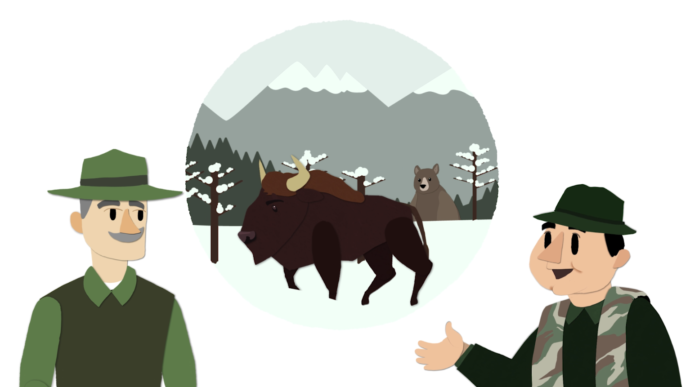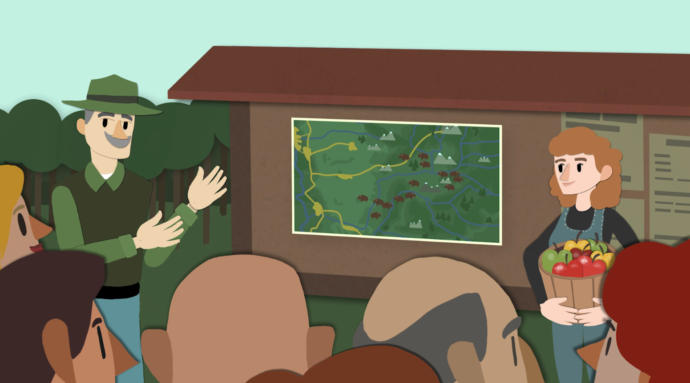New animation promotes human-bison coexistence in the Southern Carpathians

Animation on bison-human coexistence
The short video, which is being shown to both residents and visitors in the Southern Carpathians rewilding area in Romania, educates people how to behave when they encounter a European bison. It is one of a range of measures employed by the local rewilding team to promote harmonious human-bison relations.
Keeping the peace
Animals don’t recognise the boundaries and borders that humans draw on maps. When rewilding leads to the recovery of wildlife populations – either naturally, or through reintroductions – it is therefore critical to employ measures that promote human-wildlife co-existence.
Maintaining harmonious relations between humans and reintroduced European bison is the aim of a new animation produced by the Rewilding Southern Carpathians team and WWF Romania. With Rewilding Europe and WWF Romania working to reintroduce bison in the Southern Carpathians of Romania since 2014, the short video has been funded through the European Commission-funded LIFE Bison project. It will be shown to both local residents and visitors from now onwards.
“The animation tells people how to behave when they meet a bison,” explains Florin Hălăștăuan, a project officer attached to the Rewilding Southern Carpathians team. “In terms of interacting with people, these animals don’t pose an immediate danger, but we have to remember they are still wild. We want people to live safely alongside bison and enjoy these magnificent creatures without any risk to the animals or themselves.”
Timely tips
Launched online today , the two-minute animation has been produced in both English and Romanian, and contains information and advice for a range of bison encounter scenarios. The most important tip is to give the animal or animals space, staying at least 100 metres away at all times. If the bison are twitching their tails or pawing their hoofs, which is an indication they may be stressed, this distance should be slowly increased. Flashes from cameras or smartphones can aggravate bison and should not be used in the animals’ presence.
An encounter with a bison in the rewilding area is far more likely in the winter, which makes the release of the animation particularly timely.
“When the weather is harsh bison tend to move to lower elevations looking for shelter and food,” explains Hălăștăuan.
Minimising interaction
All reintroduced bison in the Southern Carpathians undergo a period of acclimatisation to local natural and climatic conditions before they are fully released and become free roaming. Some animals regain their survival instincts more slowly than others, however, depending on the frequency of their interactions with humans, and the feeding habits acquired at their former zoos and reserves.
In extreme weather conditions, bison rangers distribute hay, concentrate and mineralised salts in parts of the rewilding area usually frequented by the bison. This means they are less likely to wander into villages. A number of electric fences have also been installed, but only in high-risk localities.

Harmony between the community and wildlife
Part of the process
Like the winter feeding, the new animation is just the latest of a range of measures employed by the Rewilding Southern Carpathians team and WWF Romania to ensure harmonious relations between reintroduced bison and local residents.
One of the best ways to promote human-bison coexistence has been to ensure people benefit economically from the reintroduction programme. In 2018, 350 people took guided bison safaris in the Southern Carpathians rewilding area through the European Safari Company – a unique experience in Europe. Such tourism brings invaluable jobs and income to local people and is critical to ensuring the animals’ acceptance.
As members of the Southern Carpathians rewilding team, bison rangers not only monitor the bison, but also keep in regular touch with residents in the rewilding area, addressing concerns and dealing with any potential issues in a proactive way. Last year they distributed a brochure and poster featuring information about the bison monitoring process and tips on bison safety.
An intervention group made up of local volunteers has also been established with the assistance of the mayor of Armenis (a town in the rewilding area). The group can quickly guide bison to more remote locations if they come too close to towns and villages.
Record-breaking return
Building on a history of reintroductions in other countries, Rewilding Europe and WWF Romania have been working to reestablish free-roaming populations of European bison in the Southern Carpathians of Romania for the last six years. This record-breaking reintroduction programme became the LIFE Bison project in 2016, and the new animation has been produced under the project framework.
The reintroduced bison have certainly touched many people’s lives, as was beautifully illustrated by the recently released short film Zimbrul by award-winning French videographer Emmanuel Rondeau.
Want to know more?
- Bison tracking with the European Safari Company
- Rewilding Southern Carpathians Facebook page
- Watch Zimbrul
Blog entries express the views and opinions of their authors, which might not always fully overlap with those of Rewilding Europe.